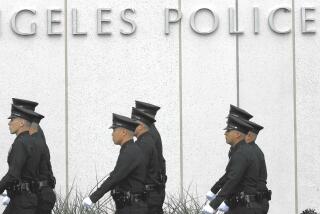LAPD adopts new rules on probing officer-involved crashes
- Share via
Acknowledging major problems with the quality of its investigations into serious traffic collisions involving officers, the Los Angeles Police Department on Tuesday announced new rules intended to improve the thoroughness and credibility of the inquiries.
The move follows a pair of Los Angeles Times articles in January that examined the human and financial toll of officer-involved accidents. The Times found that police caused about 1,250 crashes over the last three years — an average of about one a day. Most were minor, but some resulted in life-threatening injuries or were the result of the officer violating traffic laws, according to LAPD records. In at least two incidents, the driver of another car was killed.
Under the terms of the revamped policy, any time an officer is involved in a traffic accident in which someone is killed or injured badly enough to require hospitalization, a team of detectives and officers trained in crash reconstruction will go to the scene immediately.
The team will preserve skid marks and other physical evidence needed to reconstruct the crash and will interview witnesses and compel the officers involved to give their account of what happened, Cmdr. Michael Williams told the Los Angeles Police Commission at the oversight board’s weekly meeting.
Until now, LAPD officers involved in crashes had not been required to speak with investigators, while witness interviews were conducted by regular officers who failed to ask pertinent questions, Williams said. Also, crucial physical evidence was often compromised because accident scenes were not secured, he said.
He added that crash investigations have suffered from a lack of continuity and expertise because investigations are typically started by the department’s crash experts and then reassigned to detectives who are not required to have experience with traffic accidents. Going forward, the crash response teams will handle the investigations from start to finish.
Calling driving “one of the most dangerous things that our officers do,” Chief Charlie Beck said the new rules were a much-needed change. “It’s not just about money, although money is important. It is about officer safety and the safety of the public,” he said.
The LAPD’s poor investigations, Williams said, have created “serious obstacles” for police officials and city attorneys as they try to determine whether officers are to blame for crashes and to defend the city against lawsuits.
If an officer interviewing a witness, for example, fails to document whether the witness saw the police vehicle’s emergency lights and sirens on at the time of the crash, it can weaken the city’s position during settlement negotiations or trial, Williams said.
Curtailing traffic-related lawsuits — and lawsuits in general — has become a top priority for the LAPD in the last year.
The city has paid nearly $24 million in settlements or verdicts in about 400 LAPD traffic-related lawsuits over the last nine years and must contend with dozens more cases that remain unresolved, according to the Times reports.
The drain on city coffers caused by judgments and settlements in LAPD lawsuits has persisted for decades, and city officials have expressed increasing frustration recently as they struggle to close a yawning budget deficit.
Traffic-related cases account for about a quarter of all lawsuits against the department, according to a Times review of city records. Lawsuits involving civil rights violations and workplace issues, such as harassment and retaliation, are also serious concerns.
Richard Drooyan, president of the civilian commission, called the changes “a big step forward” in the department’s ongoing effort to rein in litigation.
Drooyan asked if investigators will continue to make use of speed and braking data captured by on-board computers that are akin to airplane black boxes. Williams assured him they would.
In a brief interview after the meeting, Officer Jahna Beard, one of the LAPD’s crash experts, explained that investigators rely on the data to corroborate the conclusions they reach through their crash reconstruction models and would not use the information on its own to determine the speed an officer was driving.
The issue was at the center of a fatal 2009 collision in which a 25-year-old woman was killed when an LAPD cruiser without its emergency lights and siren on broadsided her car.
The department’s reconstruction experts concluded that the officer was traveling about 50 mph, and LAPD officials cleared the officer of wrongdoing. Data from the onboard computer, however, showed that the car’s speed was nearly 80 mph, and, based on that information, the city settled last year with the woman’s family for $5 million.
More to Read
Sign up for Essential California
The most important California stories and recommendations in your inbox every morning.
You may occasionally receive promotional content from the Los Angeles Times.











